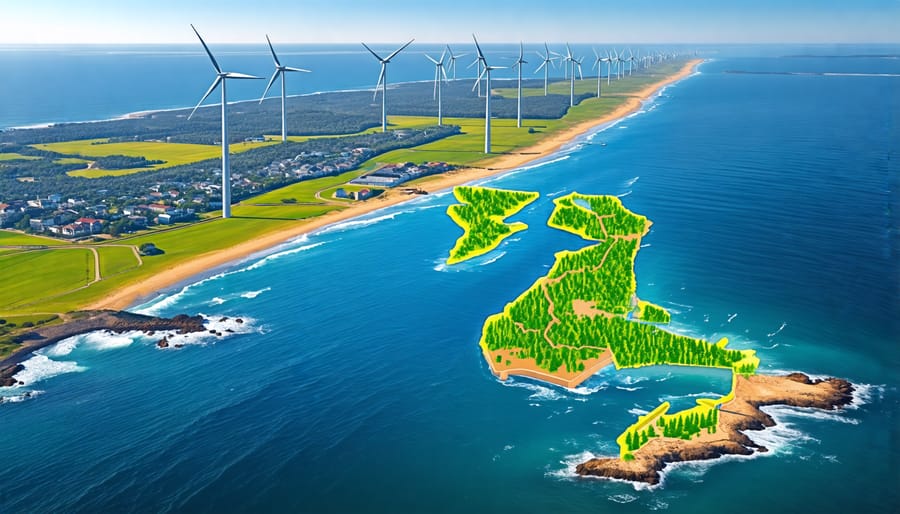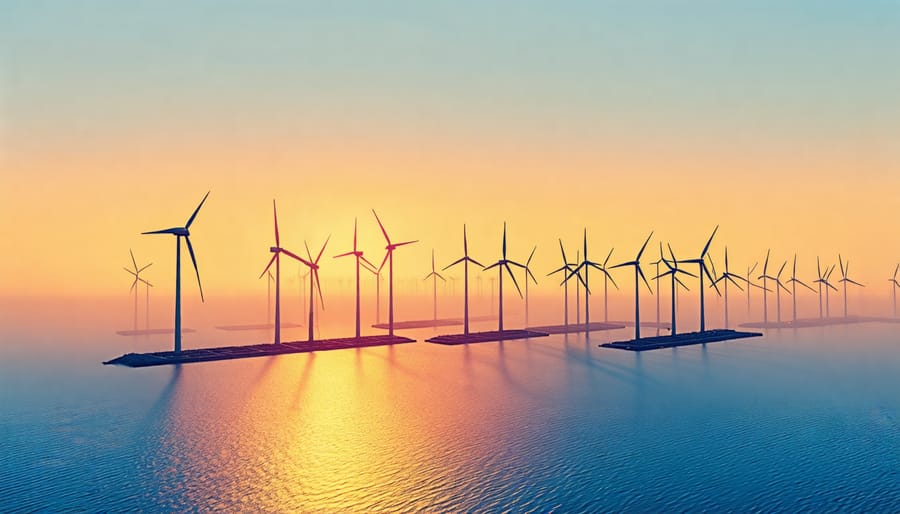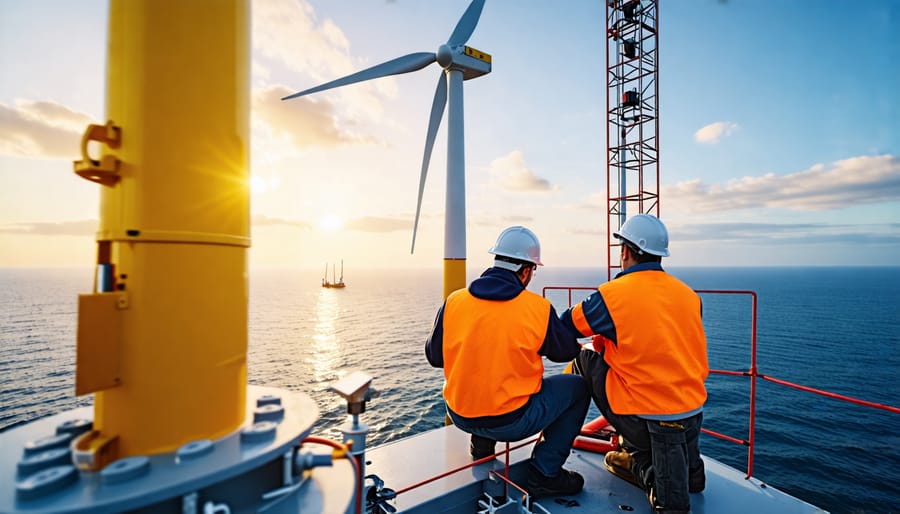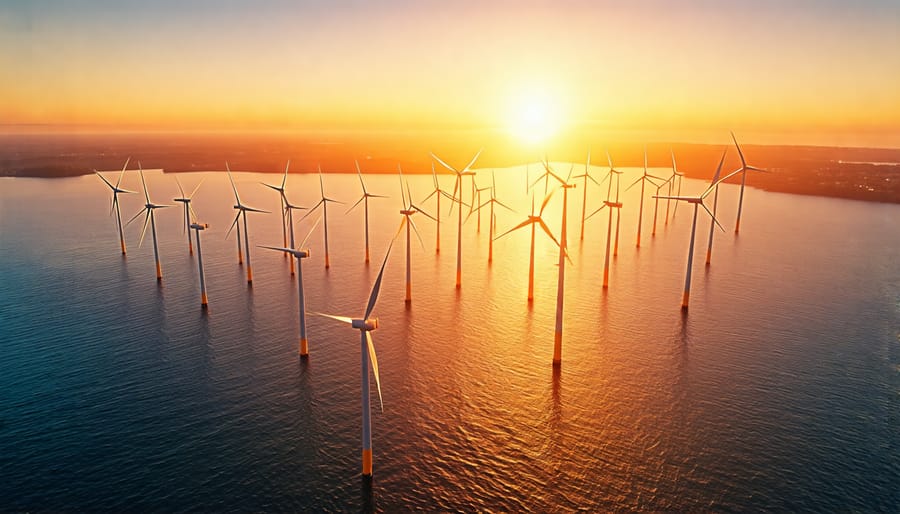New Jersey is making waves in the renewable energy sector with ambitious plans for offshore wind development. With a target of 7,500 megawatts of offshore wind energy by 2035, the Garden State is poised to become a national leader in clean power generation. Major projects like Ocean Wind, Atlantic Shores, and Empire Wind promise to deliver thousands of megawatts of emissions-free electricity to the state’s grid. These developments are expected to create thousands of jobs, attract billions in investments, and significantly reduce New Jersey’s carbon footprint. However, challenges remain in navigating environmental concerns, securing necessary approvals, and building out transmission infrastructure. As the state forges ahead, the success of its offshore wind initiatives could serve as a model for other coastal regions seeking to transition to a green energy future.
NJ’s Offshore Wind Targets and Policies

Executive Order 92
In 2020, Governor Phil Murphy signed Executive Order 92, setting an ambitious target for New Jersey to develop 7,500 megawatts (MW) of offshore wind energy by 2035. This groundbreaking order positioned the state as a leader in the rapidly growing offshore wind industry in the United States. The 7,500 MW goal represents a significant increase from the previous target of 3,500 MW by 2030, demonstrating New Jersey’s commitment to transitioning to clean, renewable energy sources.
Executive Order 92 calls for a strategic plan to achieve this goal, including a framework for job creation, workforce development, and environmental protection. The order emphasizes the importance of collaboration between state agencies, industry partners, and local communities to ensure the successful implementation of offshore wind projects. Additionally, it directs the New Jersey Board of Public Utilities to establish a robust process for soliciting, evaluating, and approving offshore wind projects that align with the state’s energy and environmental goals.
By setting this ambitious target, New Jersey aims to attract investment in the offshore wind sector, create thousands of high-quality jobs, and reduce greenhouse gas emissions. The development of 7,500 MW of offshore wind energy is expected to power millions of homes and businesses, contributing significantly to the state’s goal of 100% clean energy by 2050.
Offshore Wind Economic Development Act
In 2010, New Jersey passed the Offshore Wind Economic Development Act (OWEDA) to jumpstart the state’s offshore wind industry. This groundbreaking legislation provides financial assistance and incentives for companies developing offshore wind projects along the New Jersey coast. OWEDA establishes an offshore wind renewable energy certificate program, allowing developers to earn certificates for each megawatt-hour of electricity generated by their offshore wind farms. These certificates can then be sold to utilities, helping to offset the higher costs associated with offshore wind development.
Additionally, OWEDA offers up to $100 million in tax credits for qualified offshore wind projects, further incentivizing investment in this clean energy sector. The act also directs the New Jersey Board of Public Utilities to develop an Offshore Wind Strategic Plan, outlining the state’s long-term goals for offshore wind development and identifying potential areas for wind farm construction. By providing crucial financial support and establishing a clear regulatory framework, the Offshore Wind Economic Development Act has played a pivotal role in positioning New Jersey as a leader in the burgeoning offshore wind industry, attracting major investments and paving the way for a cleaner, more sustainable energy future.

Planned and Proposed Projects
Ocean Wind
Ørsted, a global leader in offshore wind energy, is developing the Ocean Wind project off the coast of Atlantic City, New Jersey. This ambitious 1,100 megawatt (MW) project is expected to power 500,000 homes with clean, renewable energy once operational. The project will feature state-of-the-art wind turbines, each capable of generating up to 12 MW of electricity, making them some of the most powerful in the world.
Ocean Wind represents a significant step forward in New Jersey’s commitment to renewable energy and combating climate change. By harnessing the strong, consistent winds off the Atlantic coast, this project will help reduce the state’s reliance on fossil fuels and lower greenhouse gas emissions. In addition to its environmental benefits, Ocean Wind is expected to create thousands of jobs in construction, manufacturing, and maintenance, providing a boost to the local economy.
Ørsted is working closely with local stakeholders, including fishing communities and environmental groups, to ensure that the project is developed responsibly and with minimal impact on marine life and coastal ecosystems. The company’s experience in building and operating offshore wind farms around the world will be invaluable in successfully delivering this transformative project for New Jersey.
Atlantic Shores
Atlantic Shores, a joint venture between Shell and EDF Renewables, is set to make a significant contribution to New Jersey’s offshore wind goals with their planned 2,300 MW project. The project, located off the coast of Atlantic City, aims to provide clean, renewable energy to over 1 million homes in the state.
The Atlantic Shores project will span an area of approximately 183,000 acres, utilizing state-of-the-art wind turbine technology to maximize energy production while minimizing environmental impact. The joint venture brings together the expertise of two industry leaders: Shell’s extensive experience in offshore operations and EDF Renewables’ proven track record in wind energy development.
This collaborative effort is expected to create thousands of jobs in New Jersey, ranging from construction and installation to operations and maintenance. Atlantic Shores is committed to working with local communities, businesses, and educational institutions to ensure that the economic benefits of the project are felt throughout the state.
In addition to its economic impact, the Atlantic Shores project will play a crucial role in reducing New Jersey’s carbon footprint. By generating 2,300 MW of clean energy, the project will help the state move closer to its goal of 100% clean energy by 2050, combating climate change and improving air quality for residents.
As the project progresses, Atlantic Shores will continue to engage with stakeholders, conduct thorough environmental assessments, and employ best practices to ensure the sustainable development of this offshore wind project. With its significant capacity and the combined strengths of Shell and EDF Renewables, Atlantic Shores is poised to be a major contributor to New Jersey’s clean energy future.
Other Proposed Projects
In addition to Ocean Wind and Atlantic Shores, several other offshore wind projects have been proposed for the New Jersey coast. Beacon Wind, a joint venture between Equinor and BP, is planning to develop a 1,230 MW project located approximately 20 miles off the coast of New Jersey. This project, if approved, could provide clean energy to over 850,000 homes in the state. Another potential project is Liberty Wind, proposed by Avangrid Renewables and Copenhagen Infrastructure Partners. This 1,200 MW wind farm would be situated roughly 30 miles east of Cape May County and could power an estimated 700,000 New Jersey households. These additional projects demonstrate the growing interest and investment in offshore wind energy along the New Jersey coast. As these proposals move through the approval and permitting process, they could significantly contribute to the state’s ambitious renewable energy goals, create thousands of jobs, and position New Jersey as a leader in the offshore wind industry.
Environmental and Economic Impacts
Emissions Reduction
New Jersey’s ambitious offshore wind projects are poised to make a significant impact in reducing the state’s carbon emissions. By transitioning to offshore wind, NJ aims to generate 7,500 megawatts of clean, renewable energy by 2035. This shift away from fossil fuels is estimated to prevent approximately 13.8 million metric tons of carbon dioxide emissions annually – equivalent to taking nearly 3 million cars off the road each year.
According to experts, offshore wind has the potential to supply a substantial portion of New Jersey’s electricity needs while dramatically cutting greenhouse gas emissions. The carbon avoidance enabled by these projects will be a critical step in meeting the state’s goal of 100% clean energy by 2050 and mitigating the impacts of climate change.
Real-world examples from other regions demonstrate the emissions reduction potential of offshore wind. For instance, the Block Island Wind Farm in Rhode Island, America’s first operational offshore wind project, has offset over 211,000 metric tons of CO2 since its inception in 2016. As New Jersey scales up its offshore wind capacity, the positive environmental impact will be even more pronounced, setting an example for other states looking to decarbonize their energy systems.
Job Creation
New Jersey’s offshore wind projects are projected to create thousands of new clean energy jobs across the state. According to the New Jersey Economic Development Authority, the state’s goal of generating 7,500 MW of offshore wind power by 2035 could result in up to 4,300 new jobs annually. These jobs will span various sectors, including construction, manufacturing, operations, and maintenance.
During the construction phase, jobs will be created in areas such as turbine assembly, foundation installation, and cable laying. As New Jersey establishes itself as a hub for offshore wind manufacturing, the state is likely to see an increase in jobs related to the production of wind turbine components, such as blades, nacelles, and towers. Local businesses, such as steel fabricators and marine transportation companies, will also benefit from the growth of the offshore wind industry.
Once the wind farms are operational, long-term jobs will be created in the areas of operations and maintenance. These positions will require skilled technicians to monitor, inspect, and repair wind turbines, substations, and other infrastructure. The development of offshore wind projects will also create indirect jobs in supporting industries, such as environmental consulting, engineering, and logistics.
To ensure a skilled workforce is available to meet the demands of the growing offshore wind industry, New Jersey is investing in workforce development programs. These initiatives aim to provide training and education opportunities for residents, equipping them with the necessary skills to succeed in clean energy careers. By prioritizing job creation and workforce development, New Jersey is positioning itself as a leader in the transition to a clean energy economy while fostering economic growth and opportunities for its residents.

Challenges and Considerations
While offshore wind projects offer significant benefits in terms of clean energy production, it’s important to carefully consider and mitigate potential impacts on marine life, fishing, shipping, and tourism. Rigorous environmental impact assessments must be conducted to ensure wind farm locations minimize disruption to wildlife habitats and migration routes. Collaboration with the fishing industry is crucial to address concerns about restricted access to fishing grounds and potential effects on fish populations. Shipping lanes may need to be adjusted to accommodate wind turbines, requiring coordination with maritime authorities. Tourism could potentially benefit from offshore wind as an attraction, but visual impacts on coastal views should be taken into account. With proper planning and stakeholder engagement, New Jersey can responsibly develop its offshore wind resources while protecting its valuable marine ecosystems and industries.
While New Jersey’s offshore wind ambitions are promising, building turbines in the Atlantic Ocean poses significant technical challenges. The harsh marine environment, with strong winds, high waves, and corrosive saltwater, puts immense stress on the turbines’ structures and components. To withstand these conditions, the turbines must be engineered for durability and resilience, using advanced materials and protective coatings.
Maintaining the turbines post-installation also presents logistical hurdles. Servicing offshore wind farms requires specialized vessels, skilled technicians, and careful planning around weather windows. Developers must establish efficient operations and maintenance strategies to minimize downtime and ensure the turbines’ long-term performance.
Despite these challenges, ongoing research and innovation in the offshore wind sector are yielding solutions. For example, the use of drones and AI-powered monitoring systems can streamline inspections and predictive maintenance. As New Jersey and other states continue to invest in offshore wind, the industry will undoubtedly rise to meet the technical challenges head-on, paving the way for a cleaner, more sustainable energy future.





